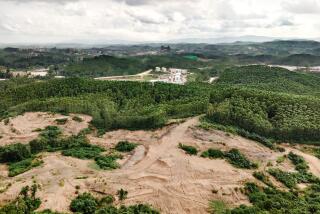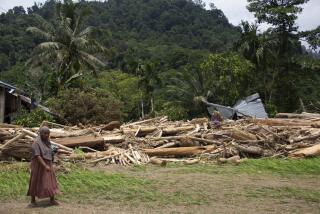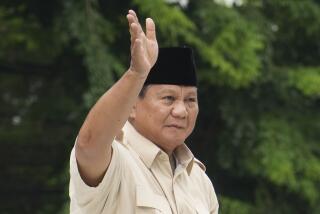An archipelago that eludes explanation
One of the principal legacies of the suppressed democracy movement at Tiananmen Square in 1989 was the publication of hundreds of books in English purporting to explain China. Fifteen years earlier, when Japan was establishing a new economic empire, U.S. executives scoured samurai treatises on war for the secret of the nation’s phenomenal business success, making them bestsellers. Japan and China had been there for centuries, waiting to be explained, but it wasn’t until they posed a challenge to American power that the desire to understand them became widespread, and they were wrested from fusty Orientalists and delivered to writers of pop history and sociology.
A bombing linked to the Al Qaeda terrorist network that killed 202 people at a pair of nightclubs on the Indonesian island of Bali last October -- and a recent bomb attack at an American-managed hotel in Jakarta, which killed 11 people -- has focused renewed international attention on this fourth most populous nation in the world.
And there’s a lot to explain: Indonesia occupies an archipelago of more than 17,000 islands stretching from the Indian Ocean to the South Pacific; it is also the third largest democracy on Earth, a fragile experiment launched just five years ago, when the tyranny of former President Suharto, whose government was the only one the republic of Indonesia had known for 32 years, was felled by a street revolution. It has the freest press in the region.
For years there has been an imperative need for a solid, comprehensive introduction to this immense, baffling nation. Now there are two, by Australian historian Jean Gelman Taylor and by Theodore Friend, former president of Swarthmore College.
They have their work cut out for them. For most Americans, Indonesia is a void: Java is a computer language or corny slang for coffee, not the most populous island on Earth, home to more than 100 million souls. The only fact about Indonesia that has percolated to the level of common knowledge is the phrase “largest Muslim nation in the world,” which has appeared in thousands of news stories in recent years. However, the intersection between Islam and political unrest in the archipelago has pushed many U.S. journalists to shoehorn Indonesia into the global story of Muslim terrorism, and the results are usually tendentious, inaccurate stories.
One tiny example will have to stand for many complex ones: That journalist’s standby “the largest Muslim nation in the world” is a classic factoid. Indonesia is not a Muslim nation, not in the sense that Saudi Arabia or even Malaysia is. The nation’s constitution affirms belief in God in the singular, nothing more. It is accurate to say that Indonesia has the largest Muslim population of any country on Earth.
Part of the problem is that Indonesia is so complicated; it resists being summed up, as journalism demands. It’s a huge, sloppy, confusing place, comprising many diverse ethnic and social groups speaking hundreds of languages and dialects -- a country that resembles our own in many ways. Its early history is hopelessly confusing, with endless squabbling among Hindu kingdoms and Muslim sultanates. Wars of conquest ended in baroque diplomacy, then came centuries of Dutch colonialism and finally the founding of the modern republic in 1945 by a patriot of Verdian intensity, Sukarno.
Most confusing of all is the nation’s religion. While the Indonesian government has consistently upheld the principle, at least, of the free practice of monotheistic religions, most of the nation’s citizens, as many as 200 million people, call themselves Muslim. The form most follow is different in profound ways from Islam as it is practiced in the Middle East and South Asia.
The standard journalistic summary goes something like this: “Most Indonesians adhere to a moderate, tolerant form of Islam, which incorporates elements of the islands’ Buddhist and Hindu past and local animist practices.” That’s true as far as it goes, but it gives no sense of the eccentric, magic-infused quality of Islam in Java, the cultural center of the nation, as it is practiced by the great majority of people. (On other islands, particularly Sumatra and Sulawesi, religion is more orthodox.)
The major rituals of Islam are observed: Friday mosque services attract huge turnouts, and going on the hajj -- the pilgrimage to Mecca -- is a universal aspiration. The dietary restriction against pork is observed, but the ban on alcohol doesn’t seem to apply to beer. Indonesia is more permissive about homosexual behavior and other social issues than some American states were until the U.S. Supreme Court ruled in Lawrence vs. Texas. Its principal religious and literary texts are Hindu in origin; its national symbol is Garuda, emblem of Vishnu. The country’s presidents have relied on shamans for advice more than on orthodox Muslim religious leaders.
Indonesian Islam has been carrying on an internal debate about the role of fundamentalism for centuries, but time and again those who have tried to create a pan-Islamic state in the archipelago have been subdued by pragmatic secularists. Ten years ago, the truculent, intolerant strain of jihadism that has terrorized the world in recent years was virtually nonexistent in Indonesia. Yet over the last year, Southeast Asian extremist groups have organized sufficiently to carry out a series of deadly bomb attacks. One hears a lot about anti-Americanism in Indonesia, but to a middle-class resident of Jakarta it seems subdued compared with public opinion in Western Europe.
Friend has written the first comprehensive general history of the modern nation, post-Suharto, in an attempt to answer a question posed by an Indonesian friend: “How can such a gentle and lovable people as we be so murderous to each other?” The big book he has produced is thoughtful, generous, well researched and written, and a bit odd.
The author of a prizewinning book about the Philippines, “Between Two Empires,” and a novel, Friend brings no specialized credentials to his task, but he is an accomplished scholar with a lively mind. “Indonesian Destinies” combines a mostly compelling account of events in the archipelago since World War II, interspersed with first-person accounts of his travels in the archipelago and interviews with Indonesians, from presidents to tour guides.
Friend is a fine storyteller, and his book is frequently novelistic in its psychological penetration. When he writes about Sukarno, he is closer to Dostoevsky than to a dispassionate historian: “He was seething with inchoate ambitions, bursting with instabilities, boiling over with energies of revolution, which were, to him, volcanic, natural, just.” He devotes as much space to Sukarno’s fascinating personal life (he had five wives simultaneously, one over the Koranic limit) as to his disastrous agricultural policies.
There are several lovely set pieces. A biographical sketch of Gordon Bishop, an American poet and entrepreneur who married a dancer at the court of the sultan of Yogyakarta, with whom he made and lost a fortune, reads like a bittersweet short story by Chekhov; and Friend’s account of a visit to Toraja, a secluded valley in the highlands of Sulawesi, populated by an ethnic group resident there for centuries (which converted to Christianity 30 years ago), is unabashedly joyous. A lyrical description of a trek there concludes, “I descended ledges of padi, in knife-edge awareness that I might never again know such dizzy natural happiness.”
The book’s primary limitation is that it reflects an American point of view on nearly every page. Friend is certainly no apologist for U.S. foreign policy; his account of the CIA’s failed attempt to destabilize Indonesia and bring down Sukarno is detailed and unsparing. Yet events are always filtered through an American lens. When Friend meets Indonesia’s great novelist Pramoedya, it leads him to an insight about Ernest Hemingway. When he narrates Suharto’s annexation of East Timor in 1975, he devotes more space to the role of Henry Kissinger than to events on the ground.
“Indonesian Destinies” is a bit bulky and overstuffed with statistics and charts, and Friend devotes 40% of the book to the last six years. He never answers the question he poses in his prologue but settles for reeling off familiar, inconclusive generalizations. For inspiration he turns to Reinhold Niebuhr and V.S. Naipaul. The former was undoubtedly as great a thinker as Friend believes him to be, but Naipaul’s nonfiction may not be the best place to look for wisdom about the developing world. It is a surprisingly weak close to an idealistic, passionately subjective work.
Of course, contemporary academic history regards such things as lyrical descriptions of nature and touches of Chekhovian irony -- and most particularly idealism and passionate subjectivity -- as anathema. “Indonesia: Peoples and Histories,” a history of the archipelago from Homo erectus to Megawati by Jean Gelman Taylor, takes a scientific, purely phenomenological approach to a vast subject. A senior lecturer at the University of New South Wales, Taylor tells the reader no stories.
She also eschews the current academic fashion for ism-grounded histories (polemical exercises in feminism or postcolonialism or what have you) and attempts to write a comprehensive social history devoid of bias or point of view -- national, political or otherwise. She goes about it with a rigorous intellect, keeping a careful eye on every aspect of her undertaking, particularly its vocabulary. Beginning with her subtitle, she abjures the word “history” in the singular. “I have tried to tell Indonesian histories through byways and minor characters, as well as through big events, to bring in ordinary lives, problems, and encounters,” she writes in the preface. “There are myriads of Indonesian histories. Only a sampling exists between the covers of this book.”
The passage reveals the book’s strength -- its wide-ranging research, which presents voices usually overlooked by Eurocentric and Javacentric historians -- as well as its limitation, a rigid bar against any analysis that holds a unified point of view. To say there are “myriads of Indonesian histories” is a commonplace observation; in one sense of the word, there are as many histories as there have been people who lived in the archipelago. It’s a point worth making, perhaps, then is set aside in the interest of telling a single history, the author’s.
Occasionally, Taylor’s search for absolute intellectual pH-neutrality verges on the absurd. Nothing is too obvious to remain unstated: “Archipelago sailors did not develop oceangoing navigation skills to carry them on journeys of many months across vast expanses of open water, and so they did not reach Europe. They did not establish Indonesian trading communities in European coastal cities.” Nor did the Aztecs colonize Spain: What’s the point? By these logical calisthenics Taylor achieves a theoretical peak of perfect evenhandedness, but the actual content is inane. Paradoxically, although Taylor’s avowed purpose is to give voice to those people usually overlooked by historians, she does so in ways that make them seem unreal. When she describes the creation of Javanese colonies on a nearby island after the defeat of the rebel Diponegoro in 1830, she says the exiled princes “created Javanese neighborhoods in Sulawesi settings.” On the next page, she tells the reader the commoners of that era “hated the foreigners who traveled through their landscapes.” Trends such as these “encouraged the Dutch to bind Indonesian histories into a single space.” These deliberately lifeless abstractions exclude the effects of events on ordinary human affairs, which cannot be told except with a point of view: Sulawesi is a real place, which exists in history, whereas “Sulawesi settings” belong to the shadow world of “histories.” The xenophobic commoners have the artificiality of figures in a Dutch Baroque painting. A single space is an idea created for histories, not a place inhabited by real people.
The book is also seriously flawed by the decision to splinter off odds and ends of text into “capsules,” like sidebars in a newsmagazine. There are 94 of them, and they make the book difficult to read.
Nonetheless, Taylor’s rigorously factual view of history and her far-ranging research should give her book a prosperous life as an undergraduate text. Her approach challenges and opens the mind: It is invigorating to read about events in Borneo, Sumatra, Sulawesi and Maluku (the Moluccas), islands most historians treat primarily as objects of conquest and diplomatic spoils. As off-putting as the book’s cool, sleek anti-tone can be at times, Taylor is a voluptuous writer. Here she captures a sparkling view of the almost mystical allure of history: “The soil of Indonesia’s mountainsides, forests, and plains has thrown up texts on stone, gold, copper, ceramic, and bone.”
These two books occupy opposing poles in the modern practice of history: If Friend’s book is too idiosyncratic and personal to be an altogether satisfactory introduction to a complex subject, Taylor’s work seems to be more calculated to pass the scrutiny of her colleagues than to meet the needs of most nonacademic readers. It may be naive, but how one wishes someone with Taylor’s disciplined mind and vast knowledge of Indonesia would emulate Friend’s enthusiasm, throw scholarly caution to the winds and have a go at explaining Indonesia.
More to Read
Sign up for Essential California
The most important California stories and recommendations in your inbox every morning.
You may occasionally receive promotional content from the Los Angeles Times.










